This doesn't exactly pertain to this post, but I just wanted to let you know, as an engineer, and a college student you're recipes are great. For those of us that really suck at cooking, your recipes give really great description on how to not screw things up, and do it all with the least amount of trouble. Definetly going to visit your blog on a regular basis
Like you say, everyone who makes tuna casserole makes it a different way. Imagine my surprise when, after twenty years of eating my mom's tuna casserole, I found out that EVERYONE else in the world makes it with noodles. My family makes it with white rice. I'm still too disoriented to evaluate other tuna casseroles!
Yours looks pretty yummy, though. I might just have to take the plunge and give noodles a try.
Your blog's pretty cool! Just loved the way you show the recipes! Great! Great! Keep up with the great job! :D
I have a completely off-topic question.
How does "All-purpose" flour compare to the UK's "Plain flour"? I ask, because I have seen American recipes use "all-purpose" for some breads. In the UK, only "strong" flour has adequate gluten/protein to use in leavened bread.
Any idea how the gluten / protein content compares?
I've just had a look at some flour, "plain" = 9.7g protein per 100g, "strong" = 11.7g protein per 100g.
Sorry about the off-topic again.
Hey,
I like the end result there, I could live with that. My kids won't touch tuna though, I'm out of that loop. Which is why sometimes I end up making two complete meals for dinner, sigh.
Try the tuna in olive oil, water degrades the fish meat.
Biggles / http://www.meathenge.com/
It all looks great except for one thing. It's missing the massive amount of cheese necessary to make me happy [I really do believe that cheese can improve nearly everything imaginable]
re: Flour
I wrote an
article on flour because of your question. The answer to your question is that plain flour is almost the same as all-purpose flour (only with regional variation). Most breads are made with bread flours, but a number of recipes for all-purpose flour have appeared because most American households only keep all-purpose flour around. It makes a reasonable bread, but doesn't have enough protein for a good french or italian bread.
do you have to tell them it's tuna? Often as I was a kid I would instantly hate every food I hadn't had before. If I was kept out of the loop of the ingredients prior to tasting, I would love the dish, even after being told what was in it.
"Like you say, everyone who makes tuna casserole makes it a different way."
Decades later, I found out that what my mother called "Macaroni and cheese" is the garden variety Tuna Casserole made with canned tuna, macaroni, American cheese slices, cream of mushroom soup and sometimes crushed potato chips on top.
Being a cheese lover, I add even more cheese in the body of the casserole, not merely on top, and add frozen mixed vegetables to make it more of a one-course meal.
Buttered bread crumbs on top sounds like a nice variation from the slightly browned melted cheese, though!
Aileen
I like your recipe for tuna caserole starting with a roux is a great idea. My question pertains to the roux though. I alwasy start my soups with a roux, but I'll saute the veggies in butter before adding flour, and later milk or chicken base. I was wondering why you add the flour before the veggies?
I start my making the cream so that I don't over cook the vegetables. (The vegetables are cooked until just tender and then mixed into the cream.)
Tuna casserole is one of those dishes that I have never like, but for some reason thought that I should. Came across this recipe and it sounded 'different', so I thought I should give a try.
After making tonight, my opinion of this dish has changed. The version of the tuna casserole is really good, and my family agrees. I served with green peas on the side, but next time I think I will add them into the casserole.
Thanks for posting it.
I do have a site request also. It would be really nice if we could just print out the recipe card, without all the directions. Your table format is enough to cook from.
Thanks,
eric@thebacklunds.org
Great site but hey how about some veggie recipes as well
thanks
Came out great! Kind of reminds me of the frozen Stouffer's Tuna Casserole - without the bellyache from their preservatives! I stirred the white sauce into the veggies to get up all the flavorful pan brownings under the veggies.
Is whole milk needed for consistency or can this be made with skim milk or evaporated milk? (great recipes BTW, especially the brined, grilled chicken breasts)
I liked your version of the Tuna Noodle Casserole. Your step by step photos are such a pleasure! Wonderful work. I look forward to coming back and seeing what else you've "cooked up" :)
Very good recipe! I used canned salmon with dill instead of the tuna and rosemary. It made more than would fit into an 8in baking dish. I must eyeball measurements on the big side.
Thank you and I love your site!
I find that the whole milk thickens the sauce a little better and adds more flavor to the dish than skim milk. You can use skim milk, but may have to adjust the flour quantities just a little.
You could actually just sprinkle some shredded cheese on top of the casserole before sprinkling on the buttered bread crumbs (or crushed ritz crackers, panko, crushed potato chips, etc.) and get the same effect. Cheesy goodness.
A standard roux consists of equal parts flour and melted butter. The idea is to develop the right color (dirty blondish) before adding the base. The flour literally is what thickens the sauce, so I'd reccomend you make all of your rouxes by starting with flour/butter.
Good recipe, I think I'll mix it up by adding 6 oz. of shredded cheese into the sauce and sprinkle 2 oz. of shredded cheese on top and I'll probably use panko instead of bread crumbs. They brown better in the oven and will give it that nice crunchy texture.
Also I noticed there's chunks of flour in your initial roux. You can keep that from happening by slowly whisking in the flour instead of dumping it all at once (not suggesting you did that). A whisk and saucepan (with rounded corners instead of straight ones) really help in this process.
Also I'd reccomend cooking in a round casserole dish. I use 1.5 quart round corningware casserole dishes to cook casseroles and such, that way you don't get those dry corners sometimes.
What's an alternative for a gluten-free roux? Would white rice flour work? or use corn starch?
As I was making this last night my husband informed me that that isn't the way HE (his mom) makes it. I kept on with my task and when it all came out of the oven he actually liked it!! AMAZING!
I always liked frozen peas in tuna casserole thats how I had it growing up. Green beans also would be good. I never had it with mushrooms or celery but that also sounds good. never had it with rosemary or thyme either.
A Roux is deffinately the way to go. I'm making some right now with whole grain pasta, dont know how it will turn out...
the cheese this is probably good but that cheating in my opinion. I love cheese, but I like to get away from it sometimes
I liked the recipe also, although both I and my wife thought the rosemary was overdone a bit. Next time I plan to cut the rosemary to 1/2 tsp.
For the macronutrient mix I get the following:
3525 kcal, 143g fat (82g sat fat, 11g poly, 41g mono), 308g carb, 246g protein
Ideas for improving the recipe:
As mentioned above, the first thing is that I'd cut the rosemary in half, but that's just personal taste. The butter is of course a delicious ingredient, but I eat it sparingly now. Next time I try this recipe I'll try to preserve the excellent flavor, but will experiment with ways of reducing the butter. "Butter Buds" could replace about 1/2 or 2/3 of the butter without modifying the flavor or texture, both in the roux and in the breadcrumb topping, I believe. If anyone tests this out, please let me know. There are excellent nonfat milk substitutes that have more protein than whole milk and taste like 2%. I used whole milk as called for in the recipe, but will use a nonfat next time. I used a whole grain, protein enriched egg noodle for the lower GI and slight additional protein.
I liked the breadcrumbs on top. I notice that it adds 84g carbs and 17g of protein, and wonder if there's something that I could add to even out the carb/protein ratio. Maybe altering the 1c breadcrumbs to 3/4c breadcrumbs + 1/4c gluten would work without altering the taste or texture too much (I haven't tried this, so I'm just speculating here). :)
I really love your site. :) The way that you show what each step is supposed to look like is a brilliant idea because it makes the whole cooking process simple and easy to understand. It also lessens the mistakes I make since I can easily see where I got off wrong. Everything's so organized. ;) and the meals look so great. I can't wait to start trying out the recipes here.
Thanks for making cooking simple that even beginner cooks like me won't fumble it up.
Yummi!
It is even better when you leave out the nasty tuna, and add shredded, cooked chicken instead. :P
This is a great recipe! Really like starting off with a classic roux and adding the spices.
Does anyone out there have a good recipe for chicken and rice casserole?
When I saw that the title was "Cooking for Engineers", I knew the recipe would turn out. I went looking for this recipe because my son is allergic to dairy, and so we can't use any canned cream soups as a base or get any creamyness from cheese. This recipe turns out just as great if you use kosher vegetable oil margarine and unflavored soy milk (ie, don't use vanilla soy milk!). I used "whole" soy milk (not low-fat). We substituted shell pasta instead of egg noodles because my son is also allergic to egg.
The person who was looking for how to substitute a non-gluten flour in the roux might be able to use 2 tablespoons cornstarch instead of the flour, but in that case the person should mix the cornstarch first in a separate bowl with a little cold milk, thin it out with more cold milk, turn the heat off under the pot, whisk the cornstarch mix in, add in all the rest of the milk and whisk it all in before turning the heat back on. And of course to finish making a gluten-free version, use any non-wheat pasta and instead of breadcrumbs use crushed rice crackers, leftover mashed potato thinned out with extra butter, or perhaps the crushed potato chips another poster recommended (but then don't add salt to the recipe).
I also always add flour to a roux gradually, mixing each time, to prevent lumps.
I think of rosemary as a roasted potato spice, not a "tuna casserole" spice. I added 1/4 teaspoon each marjoram, thyme, minced garlic and celery seed. I used 1/2 cup chopped regular 'yellow' onion rather than green onion; it saves $ and avoids the common food poisoning/bacteria contamination going on with green onions. I added 1/4 extra celery, and I also added 1 cup of frozen peas because we historically add peas to our tuna casserole. Next time I'll add 2 cups of peas. I thought that the extra celery and peas would add extra liquid, but I found that I needed to add a little (1/4) extra soy milk to thin out the sauce enough.
Also, we didn't even bake ours. I just made it, served it immediately due to popular demand, and it was great.
I will be looking for more recipes for engineers!
I made this a few days ago, adding peas to the vegetable saute but keeping everything else to the recipe.
30 minutes wasn't nearly enough to cook the casserole through. It took about 50 minutes at 350 deg F. for me.
Could you please clarify? Under the list of ingredients it calls for 1 1/2 C of milk but in the first paragragh for preping it says 1 1/4. I think I went somewhere in between and it came out fine, but I would like to know what is best. I enjoyed this casserole, especially leftover reheated. I cut the rosemary in half and still felt it was overbearing. Do you suggest a substitute?
Thank you!
Sorry about that. It's supposed to be 2-1/2 cup of milk (the recipe summary is correct). I've corrected the main article.
If your taste buds are particularly sensitive to rosemary or your dried rosemary source is particularly powerful, just keep cutting it down until you can still detect the flavor but it is in balance with the dish. 1/2 teaspoon is too much, then try 1/4 teaspoon.
AS A GUEST TO YOUR SITE, I AM IMPRESSED. I WAS LOOKING FOR A VARIATION OF THE TUNA NOODLE RECIPE, I SUBSTITUTE COOKED SIRLOIN BURGER, USE CREAM OF ONION SOUP(WE ARE ONION FANS) ADD A LITTLE LOW FAT SOUR CREAM (1/2 CUP), AND SOMETIMES SAUTE FRESH SPINACH WITH THE ONIONS AND CELERY FOR A FLORENTINE FLAIR. I PREFER COLD TUNA SALAD INSTEAD OF WARM TUNA, SO THIS WORKS FOR US.
My mother was a professional chef and I'm generally a fan of Indian and other SouthEast Asian cuisines, so that is my bias, I know everyone is different.
But I've always thought that most American restaurants terribly underseason (especially the chains and diners). You have to go to a decently fancy restaurant to find food that doesn't taste bland. And the internet in general is always worse. It drives me nuts all the recipes with Cool Whip, American "cheese" slices, and no herbs or spices. I haven't made this particular recipe yet, but I was thinking when I do, I'm going to throw in something else, I'll let people know what I do.
But the scallions and rosemary are a great idea, and something I'd never seen before, I like that plan. It is weird that everyone wants to avoid the central innovation.
I love a nice, very sharp cheddar in my tuna casserole, but when I do this for evaluation, I'm going to try it uncheesed.
But anyone who wants cheese, I assure you, the sharpest cheddar you can find will go lovely with your tuna casserole, just mix like a cup or two right in.
Has anyone seen a tuna casserole recipe with peanut butter in it?
...Try using some bacon drippings instead of butter! :) It adds an extra layer of smokiness and complexity, especially when you're making the roux. I have a bag of bacon drippings saved up in the freezer (and straight from there, it has the consistency of butter anyway)
Thanks for an awesome recipe! I definitely messed around with a bunch of the ingredients (canned chicken instead of tuna, squash instead of mushrooms, skim milk instead of whole, cornmeal instead of breadcrumbs...) but I really think that this is a recipe that lends itself well to meddling. Thanks for the inspiration!
This turned out really well. Im not sure if uk "noodles" and USA noodles are the same thing though. I think USA noodles are
more like pasta shells / macaroni tubes, whereas I took noodles to mean the long stringy noodles you use in Japanese cooking (soba noodles). Could someone clarify for me?
Regardless of this, the dish was a hit with everyone in my household! Thanks!!
the usual for USA "tuna noodle casserole" would be the flat pasta types - altho other shapes are commonly used.
I've not seen it doe with the Japanese 'non-pasta' noodles - but why not?
I love noodles especially when still hot.
It looks so yummy.
I wanna try it at home.
Michael (and readers) -
I am writing you with a question about making tuna noodle casserole.
Decided to post even though :
- the original recipe is about 10years old and
- there have been no comments to that recipe thread in about 4 years.
I read some of the previous comments related to making the roux/sauce.
My question or curiosity is this :
- Wouldn't it build a more flavorful “sauce” if the roux were not made separate from sweating/sauteéing the vegetables ?
My thought was to proceed in this order:
- 1. Heat the liquids in a saucepan [u:e9b26db9b7]first[/u:e9b26db9b7] and set aside.
- 2. Next, heat butter/oil in skillet and sautée vegetables until [u:e9b26db9b7]almost done[/u:e9b26db9b7] ...so as to not overcook veggies
- 3. Then add flour to skillet with vegetables.
- 4. Finally, gradually pour & whisk in the hot liquids to skillet to form sauce.
...
I thought doing it this way (adding liquids to veggies, rather than already formed roux)
would help better extract and build more of the flavors into the sauce before it firmed up.
...
What do you think ?
I would welcome & appreciate any comments, thoughts or ideas on this.
...
one classic "issue" with making a roux / white / blonde / dark flour sauce is doing it lump free.
a roux works by coating the flour particles with fat - this prevents the flour particles/grains from clumping/lumping when water/milk/wine/other liquid is added. cooking the flour in the fat also does away with the "raw flour" taste of insufficiently cooked flour. that flour cooking needs to happen before adding liquids.
doing the veg saute will certainly cause the vegetables to release water - when the flour hits the hot liquid&water combo you will get glue/paste/lumps/clump immediately on contact. you may have heard the term "it seized" - i.e. it immediately turns into a lumpy gummy glob.
now, can it be done? under conditions, probably. if you're aiming for a relatively thin sauce, and the veggie chunk amount is not such a high % that it prevents effective whisking - putting the flour into a hot oil&water mix will undoubtedly crate some lumps - the question is whether you can rapidly whisk it smooth or near smooth/lump free.
typically the sauce spends 10-30 minutes cooking - I add pre-sauted stuff into the sauce, bring it up to a boil, lower the heat to a simmer, adjust the consistency before using it in a casserole. then the casserole bakes.... there's enough time for the veggie flavors to "infuse"
To Michael (and readers) -
Not sure WHY -or- WHAT happened in my last post, but
the html tags seemed to get garbled on *some* of the text.
...
Sorry if it made it harder to read.
Not sure what went wrong.
Will *not* use the tags in further postings.
..
Thanks to Dilbert for taking time to reply.
I read your comments and you make some good points about rouxs & sauces.
...
I *did* end up trying out the process I wrote & proposed.
Clumping & lumps did not seem to be an issue or problem with this batch.
Maybe for a few reasons.
1.
Carrots & celery gave off little to no water.
And I cooked the mushrooms until they gave off all/most of their liquid.
Little water/moisture left in pan by the time flour was added.
2.
Along the lines of your suggestion or comment,
I intuitively pushes veggies to side leaving a well in the center of pan,
then added a bit of butter to pan and cooked the flour for 1-2 mins to
eliminate uncooked raw taste to flour before
stirring in with the veggies
3.
Considering this was not for a sauce to pour on or "dress" a dish, but
for a casserole (w/ lots of textured ingredients)
if there was any small lumps it was certainly not evident or noticeable.
...
While I was more concerned about building a more flavored sauce,
your points to consider about sauce consistency are helpful & well-taken.
Again thanks for taking the time to comment & contribute.
.
Any ideas or comments from other readers also welcomed.
.[/b]
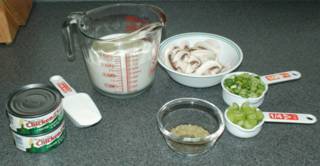 Start by assembling 12 ounces of light tuna packed in spring water, 1/4 cup all purpose flour, 2-1/2 cup whole milk, 4 oz. sliced button mushrooms, 1/2 cup chopped scallions (also called green onions), 1/4 cup chopped celery, 1 teaspoon dried rosemary, and 1 teaspoon dried thyme. I prefer to use light tuna (usually made with yellowfin and skipjack tuna) for it's milder taste and softer texture than albacore. There will be significantly less than 12 ounces of tuna after we drain the water from the fish, so go ahead and drain the tuna at this point.
Start by assembling 12 ounces of light tuna packed in spring water, 1/4 cup all purpose flour, 2-1/2 cup whole milk, 4 oz. sliced button mushrooms, 1/2 cup chopped scallions (also called green onions), 1/4 cup chopped celery, 1 teaspoon dried rosemary, and 1 teaspoon dried thyme. I prefer to use light tuna (usually made with yellowfin and skipjack tuna) for it's milder taste and softer texture than albacore. There will be significantly less than 12 ounces of tuna after we drain the water from the fish, so go ahead and drain the tuna at this point.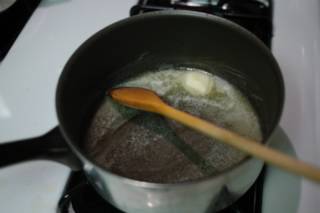 Melt four tablespoons butter in a saucepan over medium heat.
Melt four tablespoons butter in a saucepan over medium heat.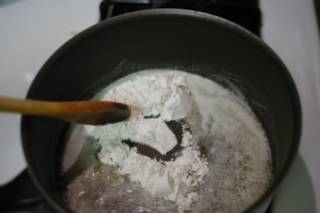 Add flour to the butter and stir for about two minutes.
Add flour to the butter and stir for about two minutes.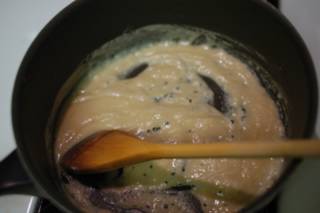 The mixture, called a roux, should become smooth and thick during the two minutes.
The mixture, called a roux, should become smooth and thick during the two minutes.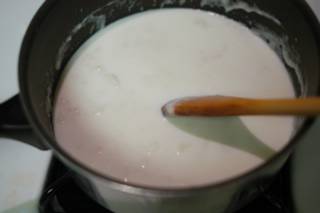 Add milk slowly to the to the roux while stirring. Continue stirring until the milk thickens. The milk mixture will easily coat the back of your spoon when you dip you spoon in and not flow off quickly when it begins to thicken.
Add milk slowly to the to the roux while stirring. Continue stirring until the milk thickens. The milk mixture will easily coat the back of your spoon when you dip you spoon in and not flow off quickly when it begins to thicken.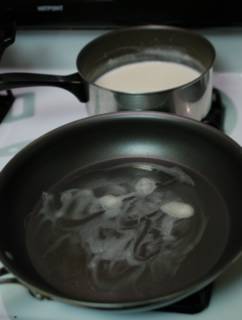 Melt one tablespoon of butter in a skillet.
Melt one tablespoon of butter in a skillet.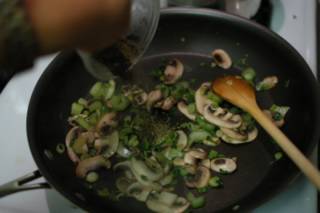 saute the vegetables until the mushrooms are tender. Then, stir in the rosemary and thyme.
saute the vegetables until the mushrooms are tender. Then, stir in the rosemary and thyme.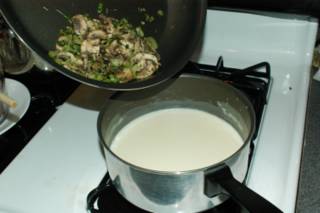 Pour vegetables into the sauce.
Pour vegetables into the sauce.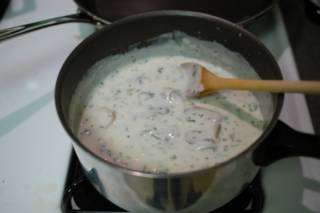 Stir until evenly mixed. This is a good time to salt and pepper the sauce. I don't actually measure the amount of salt or pepper that I use for this dish, so I add salt and pepper to taste. Add some salt and pepper, stir, and taste. Repeat as necessary.
Stir until evenly mixed. This is a good time to salt and pepper the sauce. I don't actually measure the amount of salt or pepper that I use for this dish, so I add salt and pepper to taste. Add some salt and pepper, stir, and taste. Repeat as necessary.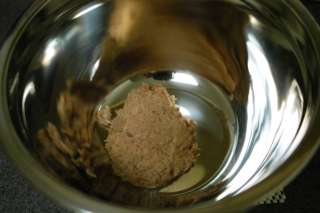 Place drained tuna into a large bowl.
Place drained tuna into a large bowl.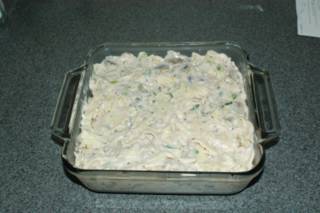 Pour noodles and sauce into the bowl containing the tuna and mix until evenly distributed. Pour everything into a greased 8x8 inch baking pan or 1.5 quart casserole.
Pour noodles and sauce into the bowl containing the tuna and mix until evenly distributed. Pour everything into a greased 8x8 inch baking pan or 1.5 quart casserole.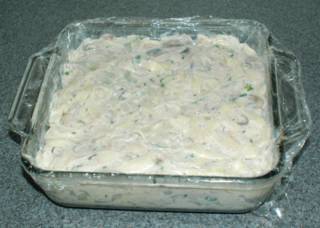 At this point, you can refrigerate the casserole for up to a couple days without baking it. I cover it with plastic wrap and press the wrap directly onto casserole so no film will form during refrigeration.
At this point, you can refrigerate the casserole for up to a couple days without baking it. I cover it with plastic wrap and press the wrap directly onto casserole so no film will form during refrigeration.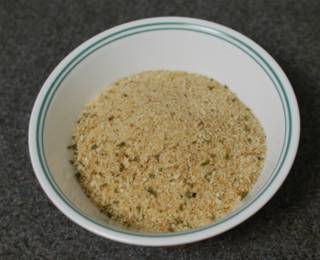 When you're ready to serve the casserole, prepare one cup of bread crumbs. I used store bought bread crumbs with herbs in this picture, but I've also used rushed crackers and plain bread crumbs from white bread successfully.
When you're ready to serve the casserole, prepare one cup of bread crumbs. I used store bought bread crumbs with herbs in this picture, but I've also used rushed crackers and plain bread crumbs from white bread successfully.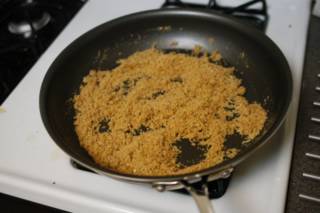 Melt four tablespoons butter in a skillet over medium heat and add the bread crumbs. Stir until the bread crumbs turn a golden brown color.
Melt four tablespoons butter in a skillet over medium heat and add the bread crumbs. Stir until the bread crumbs turn a golden brown color. Sprinkle the bread crumbs over the casserole making sure you cover most of the surface. Any bits of noodle sticking up will dry out and not be tasty, so make sure the noodles are down and covered. Bake at 350°F for thirty minutes (or until the edges begin to bubble).
Sprinkle the bread crumbs over the casserole making sure you cover most of the surface. Any bits of noodle sticking up will dry out and not be tasty, so make sure the noodles are down and covered. Bake at 350°F for thirty minutes (or until the edges begin to bubble).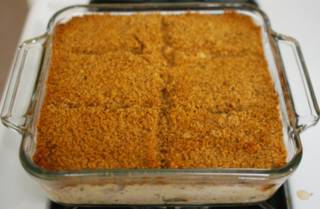 Cut the casserole after you let it cool for a few minutes.
Cut the casserole after you let it cool for a few minutes.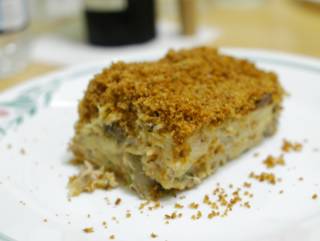 The casserole is flavorful, but not so complex that you can't taste the individual components. A great hot and hearty dinner for the upcoming autumn and winter.
The casserole is flavorful, but not so complex that you can't taste the individual components. A great hot and hearty dinner for the upcoming autumn and winter.